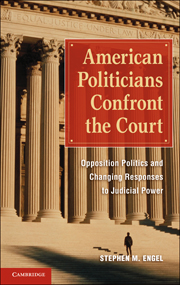 American Politicians Confront the Court
American Politicians Confront the Court Book contents
- Frontmatter
- Contents
- Acknowledgments
- Introduction
- PART I POLITICAL DEVELOPMENT AND ELECTED-BRANCH RELATIONS WITH THE JUDICIARY
- PART II HOSTILITY TO JUDICIAL AUTHORITY AND THE POLITICAL IDIOM OF CIVIC REPUBLICANISM
- PART III HARNESSING JUDICIAL POWER AND THE POLITICAL IDIOM OF LIBERAL PLURALISM
- On the Return of Opposition Illegitimacy and the Prospects for New Development
- Index
- References
On the Return of Opposition Illegitimacy and the Prospects for New Development
A Conservative Insurgency Innovates and a Self-Styled Majoritarian Court Responds
Published online by Cambridge University Press: 05 June 2012
- Frontmatter
- Contents
- Acknowledgments
- Introduction
- PART I POLITICAL DEVELOPMENT AND ELECTED-BRANCH RELATIONS WITH THE JUDICIARY
- PART II HOSTILITY TO JUDICIAL AUTHORITY AND THE POLITICAL IDIOM OF CIVIC REPUBLICANISM
- PART III HARNESSING JUDICIAL POWER AND THE POLITICAL IDIOM OF LIBERAL PLURALISM
- On the Return of Opposition Illegitimacy and the Prospects for New Development
- Index
- References
Summary
This book has traced the changing politics of hostilities toward the federal judiciary. Episodic conflicts between courts and the elected branches have been with us from the beginning of our constitutional history. They suggest a persistent and still unresolved problem over the place of an independent judiciary in a democracy. But these attacks have not been all of a piece, suggesting that this phenomenon is not merely the result of a constitutional design flaw of an unelected judiciary in an otherwise democratic republic. Their variation reflects systemic changes ongoing within the polity at large, changes that mark the development of American democracy and reveal processes of ideational and institutional change that structure the assumptions underlying rationally strategic political behavior. In particular, shifts in how elected actors understood the legitimacy and loyalty of opposition – evident in changing positions they took on threats posed by and purposes of political parties – have had a pronounced effect on politicians' solutions to the challenge of independent judicial authority. New responses to judicial power emerged in each period as politicians eyed different possibilities for democratic politics and reconsidered the utility of courts accordingly.
This account stands in stark contrast to received understandings of anti-court sentiment, hostility toward judges, and the tactics used to manipulate judicial power. Scholars have long been aware of the episodic manifestations of the problem of judicial authority in American politics.
- Type
- Chapter
- Information
- American Politicians Confront the CourtOpposition Politics and Changing Responses to Judicial Power, pp. 372 - 384Publisher: Cambridge University PressPrint publication year: 2011


